It has been a busy couple of months, hence no posts on THE RACE. In my last one, I hope I made it clear that scientists have senses of humor (my favorite ones do, anyway). Here’s another fact you might not know; regardless of what he or she studies, there is probably not a single field biologist anywhere who does not have a secret dislike or even fear of one sort of critter or another. With me, it has always been centipedes-- even when I was a child. I can’t bear the things! And, naturally, there are some real monsters common on São Tomé. The creatures in the shots below are about 10 inches long, sometimes they get larger!
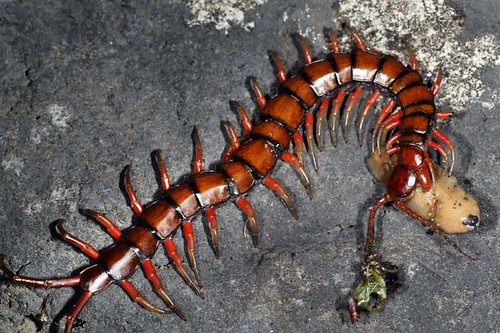
Scolopendra subspinipes. D. Lin phot. GG II

S. subspinipes - Weckerphoto, GG III
These arthropods are more properly known as scolopendras, and they are voracious predators; the upper one is devouring a slug. The two above are Scolopendra subspinipes, are native to Southeast Asia and thought to have been brought to the islands accidentally. The Academy was just visited by Dr. Rowland Shelley, a specialist on millipedes from the North Carolina State Museum, who had a look at some of our critters. He and his colleague, Dr. John Lewis of the UK identified these but, more exciting, the one pictured below.
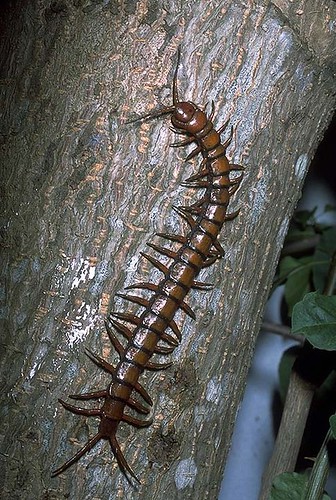
Otostigmus productus DLin phot- GG II
This is a different species that was originally described from São Tomé over 120 years ago. It is thought to also occur in West Africa; if this is the case, O. productus is not an endemic species but it is probably naturally occurring.
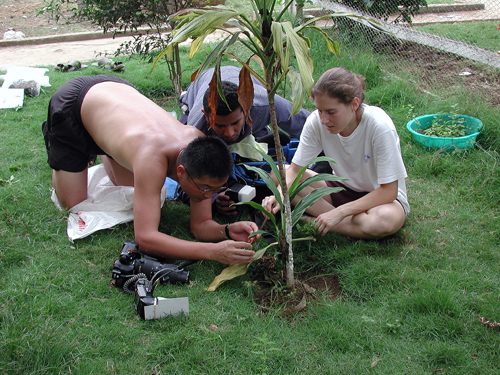
Photo shoot on Sao Tome. Dong Lin, Fabio Penny and Ricka Stoelting -RCD GGI
Ricka Stoelting (above at right), my grad student and GG I participant, is putting the finishing touches on her manuscript on the fabulous São Tomé, “cobra bobo.” After submitting it for publication, she will pursue her PhD at the University of Wisconsin.
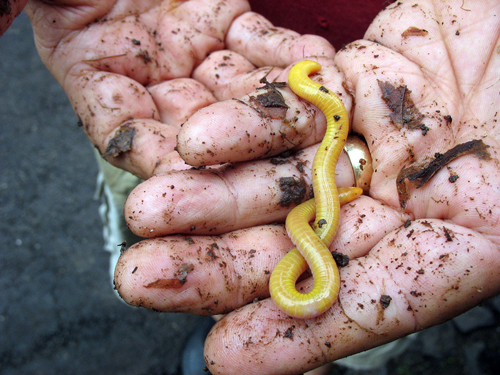
Schistometopum thomense - Weckerphoto, GG III
Ricka’s research has shown that this remarkable legless amphibian, Schistometopum thomense is indeed a true endemic species, having gotten to the island by natural means. By studying the genetics of these bright yellow burrowers, she has learned that there are two different genetic groupings of the caecilian on the island and this is possibly related to volcanic activity within the last million years.

Principe Jita. Lamprophis sp. Weckerphoto GG III
Our snake project on “cobra jita” (Lamprophis - see earlier blogs) is ongoing; my intern, Lisette Arellano (below) has returned from the University of California, Santa Barbara and is working down in our molecular lab as I write. Last summer we learned that although they are very similar in appearance, the snakes on São Tomé and Príncipe are genetically distinct from one another based on Lisette’s analysis of the cytochrome b gene. We think that analysis of an additional nuclear gene will be useful.
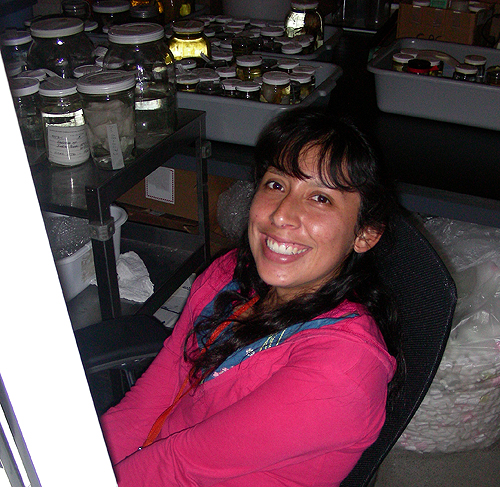
Lisette Arellano at the Academy. RCD
The big issue lies with the status of jita’s relatives on the mainland. While we are now reasonably sure that the two island populations are separate species, we do not know what their relationships are to the at least 12 species of Lamprophis distributed widely in Africa; it is possible that either or both of our island snakes could belong to one these mainland species. Unfortunately the relationships (systematics) of this whole group in Africa are poorly understood. Dr. Chris Kelly of Rhodes University who is working on the entire complex has kindly sent us a number of tissue samples of Lamprophis from some West African localities, and these are what Lisette is analyzing now. In June, Lisette is off to the University of Colorado to pursue her PhD. Hopefully, we will have figured out our island snakes by then.
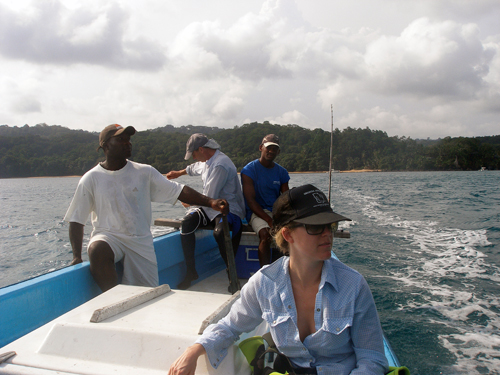
Dana Carrison off Principe. Pola-Perez phot. GG III B
Dana Carrison is an MSc candidate at San Francisco State University and was part of marine phase of GG III (see Send In the Marines). She is the graduate student of Dr. Bob Van Syoc, a participant of both GG II and III marine expeditions. Dana is nearing completion of her research on the barnacles she and Bob study and has this to say:
“The Gulf of Guinea II and III expeditions have led to the discovery of two new species of symbiotic barnacle of the genus, Conopea, originally described from the Straits of Gibraltar by Ellis in 1758. I have been using molecular and morphological methods to describe these new species and compare them with their closest barnacle relatives. I have also been comparing species of gorgonian coral with species of barnacle to see if there's any sort of settling preference. So far I think that one of the new species of barnacle is found only on a singe species of gorgonian and the other is not.”
I should mention that the gorgonians to which Dana refers are studied by Dr. Gary Williams, also a Gulf of Guinea veteran of two expeditions. Here are Dana’s new species:

Conopea new species #1 phot. D. Carrison
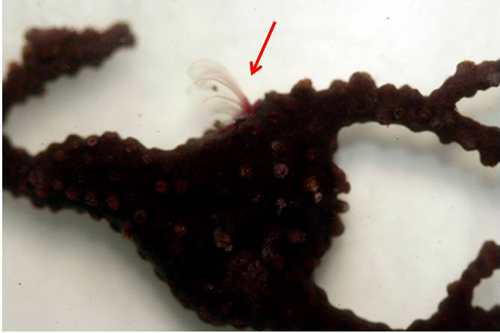
Conopea new species #2 D. Carrison phot
More anon and before our return to the islands.
Here’s the parting shot:
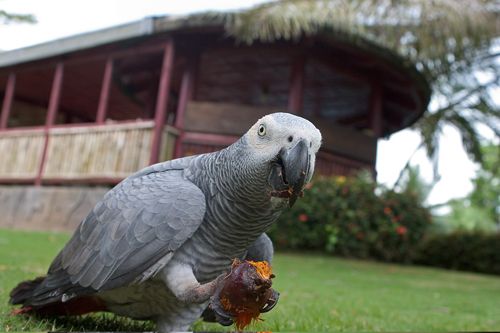
Chaplin, Executive Director, BomBom Island, Principe. Weckerphoto GG III
PARTNERS
We gratefully acknowledge the support of the G. Lindsay Field Research Fund, Hagey Research Venture Fund of the California Academy of Sciences, the Société de Conservation et Développement (SCD) for logistics, ground transportation and lodging, STePUP of Sao Tome http://www.stepup.st/, Arlindo de Ceita Carvalho, Director General, and Victor Bomfim, Salvador Sousa Pontes and Danilo Bardero of the Ministry of Environment, Republic of São Tomé and Príncipe for permission to export specimens for study, and the continued support of Bastien Loloumb of Monte Pico and Faustino Oliviera, Director of the botanical garden at Bom Sucesso. Special thanks for the generosity of private individuals, George G. Breed, Gerry F. Ohrstrom, Timothy M. Muller, Mrs. W. H. V. Brooke and Mr. and Mrs. Michael Murakami for helping make these expeditions possible.